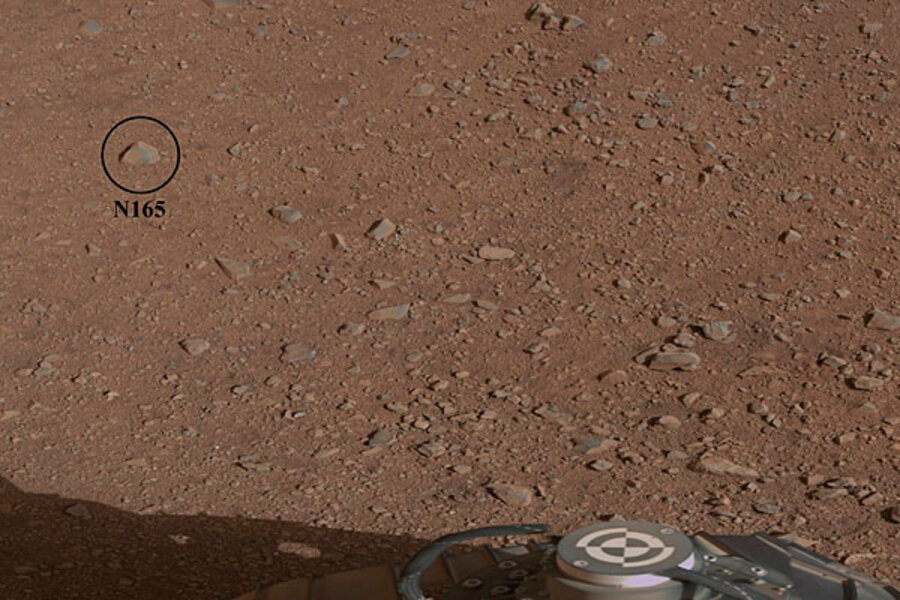What Curiosity rover is up to next: Martian target practice
Loading...
After nearly two Earth weeks on the surface of Mars, NASA's rover Curiosity is getting set for target practice.
Within the next few days, scientists using the laser-based ChemCam plan to zap their first rock, a three-inch chunk of what could be volcanic basalt sitting on the surface about nine feet from the rover.
The event will mark another milestone in the methodical checkout of 10 sets of instruments on the one-ton rover. Its mission is to hunt for signs that its new home, Gale Crater and its central summit, Mt. Sharp, might have been hospitable for life early in the planet's history. Any signs of ancient habitats will appear in the chemical makeup of the soils and rocks Curiosity analyzes.
During a briefing on Friday, Mars Science Laboratory project scientist John Grotzinger unveiled a new, high-resolution image of the foothills of Mt. Sharp, roughly four miles from the rover. The foothills – Curiosity's ultimate destination – display distinctive layering that he says is reminiscent of "the Four Corners region of the western US or maybe Sedona, Ariz."
Images of those layers taken from orbit suggest that they contain a range of minerals formed in the presence of liquid water – one of the key elements needed for organic life.
The layers provide a backdrop worthy of a John Ford-John Wayne western for Curiosity's ChemCam target practice.
ChemCam is the rover's scout. Its laser deposits several megawatts of energy onto a spot the size of a pinhead and as many as 23 feet away. ChemCam's small telescope picks up the brief spark of plasma the laser generates as it vaporizes rock samples. Spectrometers inside the rover's body extract from the spark's colors the telltale fingerprints of chemical elements across the entire periodic table.
The science team then uses that information to identify rocks it wants the rover to approach to study in detail. And as it conducts those studies, ChemCam can be taking additional measurements of other rock formations so scientists can fit what they find in up-close samples into a broader geochemical context.
Between now and the test burst – 30 shots in 10 seconds (in your face, Rooster Cogburn) – researchers will in effect be adjusting the laser's sights. The next step is to make sure the laser hits what its camera sees, says Mark Wiens, a physicist at the Los Alamos National Laboratory in Los Alamos, N.M., and ChemCam's lead scientist. Initially, the team will use a target painted onto the rover's deck. Then it will aim for the rock – to be named later.
In addition to testing ChemCam's ability to analyze the rock's composition, the science team will be looking to see if ChemCam is sharp enough to pick up changes over the first few bursts that would indicate that the rock is covered with a layer of other material – dust, for instance.
Any coatings on the rocks "can tell you about the weather or what's happened to this rock over the eons," Dr. Wiens says.
All that will come in handy when Curiosity makes its first science measurements of a patch of exposed rock the science team has dubbed Goulburn. It's one of four patches scoured clean by the blast from the rocket motors on the "sky crane" that lowered the rover to the surface.
Then it's off to Glenelg, a spot where three distinct formations of surface rocks meet. Glenelg lies in the wrong direction for a trip to the long-sought foothills of Mt. Sharp, but the contrasting surface formations made it a can't-miss science target.
That trip, however, is still a ways down the calendar.
By the end of next week, the team hopes to report ChemCam's successful target practice, as well as initial tests of the rover's maneuverability – the first roll of the wheels.
The mission then enters what Dr. Grotzinger calls intermission, a period were the team will run additional tests of instruments working together.
"After that, assuming all is nominal, we intend to hit the road," he says, with an ETA at Glenelg of three to four weeks later – if scientists don't stop along the way to ooh and ahh over what they see. Indeed, Grotzinger says he expects to arrive at Glenelg from a month to a month and a half after starting the journey.
After about a month at Glenelg, it's off to Mt. Sharp.
As for the Martian weather report, courtesy of the rover's weather station: Thursday's high temperature was 37.1 degrees Fahrenheit.







